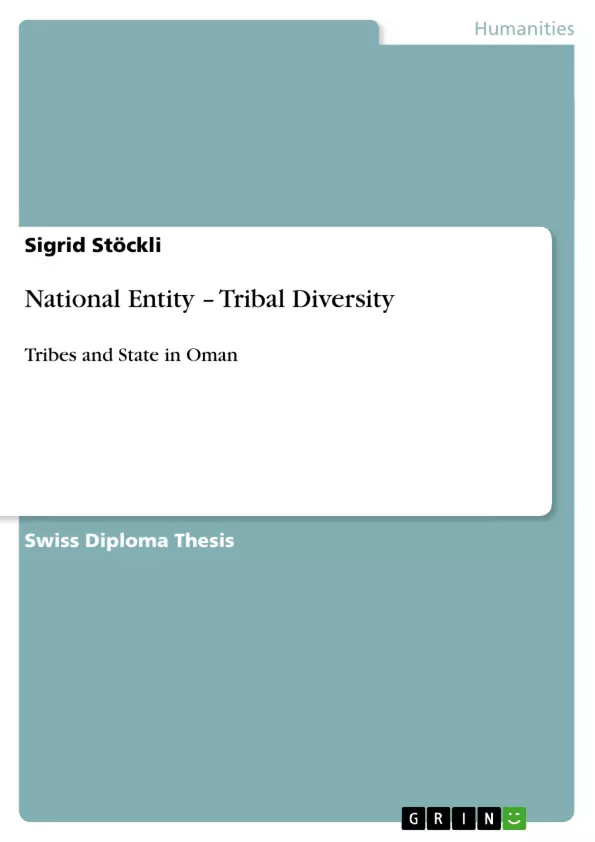This master thesis evaluates and analyses the interrelationship of tribes and the Omani state formation, hence the role and importance of tribes in people’s everyday life in comparison with the awareness of tribes on the official side. It brings into focus three main aspects:
First, an accurate definition of tribe is given. Although it is widely discussed in literature what one has to understand by tribe, this thesis mainly pinpoint the ideas and opinions of how Omani citizens apprehend their tribal identity and how they define what a tribe is. In a second step, the importance of tribal identity in people’s everyday life is evaluated. In a time where such tremendous social changes have occurred, as has been the case in Oman, where people experience prosperity and wealth and where globalising issues influence especially the younger generations, it is of considerable interest to find out what role tribal identity plays (or does not play). Third, a fuller understanding of the perception of tribes on the official side contributes to the actual debate in social science about tribes and state formation in the Middle East and examine the situation in Oman.
Inhaltsverzeichnis (Table of Contents)
- Acknowledgement.
- Transliteration
- Introduction and Background
- Oman - a Portrait
- Land and People
- Political Situation
- Islam and Ibadism
- Outline and Aim of the Research
- Relevance of Topic
- Evaluation of Literature and Latest Debates
- Literature about Oman and the Middle East
- Literature about Tribes and the Tribal Debate
- Chapter Overview
- Il Method
- Initial point of the Paper
- Genesis of the Questions
- Hypotheses
- Empirical Considerations
- Fieldwork as Gain of Knowledge
- Specific Approach in the Field
- Participating Observation
- Evaluation of Interviews
- Self-Evaluation
- Ethical Considerations
- III Definitions
- Tribes in General
- Tribes in the Arabic Context
- Tribes in Oman
- States
- Historical Account
- Constitution in Oman
- IV Theory
- Historical Perspectives
- The Discourse and its Content
- State Formation in Tribal Surroundings in the Past
- Importance of Islam
- Badū vs. Hadar
- Introduction
- Badū and Ḥaḍar in the Light of State Formation
- V Tribes and State in Oman
- Social Level
- Tell me about Your Tribe
- Characteristics and Attributes of Tribes
- Effects of Tribe in Daily Life
- Summary
- Political Level
- Observations in the Offices
- Availability of Documents
- Relationship between Tribes and Government
- Impacts of Elections
- Summary
- Analysis
- VI Concluding Remarks
- Recapitulating Review
- Outlook
- Glossary
- Appendixes
- Appendix I Governorates and Regions of Oman
- Appendix II Operationalising Tool
- Appendix III List of Interviewed Tribes' Members
- Appendix IV Interview Statistics
- Appendix V Notice Board at the Governorate of Muscat
- Bibliography
Zielsetzung und Themenschwerpunkte (Objectives and Key Themes)
This Master Thesis aims to analyze the complex relationship between tribes and the state in Oman. The author uses an ethnographic approach to explore how tribal structures are integrated into the modern Omani state, considering the historical and social context.- The historical development of the Omani state and its interaction with tribal structures.
- The role of Islam and Ibadism in shaping Omani society and the relationship between tribes and the state.
- The impact of tribal affiliations on individual lives and social interactions in contemporary Oman.
- The influence of tribal dynamics on the political landscape and the government's approach to tribal affairs.
- The author's own ethnographic observations and experiences in the field, highlighting the complexities of tribal identity in Oman.
Zusammenfassung der Kapitel (Chapter Summaries)
The Introduction and Background section introduces the reader to Oman, its geography, population, political situation, and the role of Islam and Ibadism in shaping the country's identity. This chapter sets the stage for the exploration of tribal structures within the modern Omani state. The 'Method' chapter outlines the methodology used in the research, including the author's initial questions, hypotheses, and the empirical considerations that guided her fieldwork. This section provides transparency about the research process and helps to ensure the study's validity. The 'Definitions' chapter explores various definitions of "tribe" within the context of Oman and the broader Arabic world. This chapter distinguishes between the historical and contemporary understanding of tribal structures, setting the groundwork for a nuanced discussion of their relevance in the modern state. The 'Theory' chapter delves into historical perspectives on state formation in tribal societies, examining the interplay between traditional tribal structures and the emergence of a modern state. This chapter explores the role of Islam in shaping the Omani state and the concept of 'Badū' and 'Ḥaḍar', which represent the nomadic and settled populations, respectively. The 'Tribes and State in Oman' section examines the impact of tribal affiliations on social and political life in Oman. This chapter explores how tribal structures are integrated into everyday life, including family dynamics, social interactions, and the influence of tribal identities on individual experiences. The chapter also analyzes the relationship between tribes and the government, considering the political dynamics, the availability of documents, and the impact of elections on tribal affairs.Schlüsselwörter (Keywords)
The core focus of this Master Thesis is on the relationship between tribes and the state in Oman. This includes analyzing the historical development of the Omani state, the impact of Islam and Ibadism on Omani society, the role of tribal structures in social and political life, and the author's own ethnographic observations and experiences in Oman. Key terms include: tribes, state, Oman, Islam, Ibadism, Badū, Ḥaḍar, social level, political level, fieldwork, ethnographic research.- Citar trabajo
- Sigrid Stöckli (Autor), 2008, National Entity – Tribal Diversity, Múnich, GRIN Verlag, https://www.grin.com/document/180221



